EBR charges a service fee to manufacturers to produce ebike reviews and videos. It’s the same flat fee for each bike, and it helps us to keep the site going while limiting ad clutter. We appreciate the opportunity to serve you with our opinions and data but respect your right to know that we receive compensation :)
The RadRover is a special electric bike to me because it has reached the masses by being affordable, fun, and well-supported. Rad Power Bikes sells direct, meaning that you have to take a leap of faith when purchasing online vs. trying in person and getting help from a local electric bike shop… unless you live in or near Seattle Washington where their headquarters and factory store are located. What makes this and other RPB ebikes work is the relatively low price point of $1,499, solid one-year comprehensive warranty, and attentive online and phone support. The 2018 RadRover covered in this review is their second generation offering, meaning that most of the bugs have been ironed out and a lot of the design and components have been refined or enhanced. It’s a solid product in my opinion, one that is capable and versatile. The larger 26″ x 4″ fat tires allow it to romp across dirt trails, cushion bumpy streets, and even manage soft sandy or snowy environments if you lower the pressure around 5 to 10 PSI… I have actually tested this out with the help of a resort called Cabo Adventures in Cabo San Lucas Mexico in 2016, and you can watch the video here! Just because it has big tires doesn’t mean that it’s not capable and fun on smooth pavement, especially if you raise the PSI around 20 to 30, you definitely hear the rubber knobs and the enlarged contact patch produces some drag which lowers efficiency, but that also provides some stability. One thing I noticed right away about this second generation of RadRovers is that they use a shorter steeper stem and mid-rise handlebar which can be adjusted forward for increased reach if you’re taller or prefer a sporty body position or upright if you like comfort or aren’t able to reach as far. This design and hardware change, coupled with three spacers and the adjustable seat post height, provides a range of fit options even though the frame comes in just one size. Notice the sloped top tube and consider the 26″ wheels which lower the frame a little compared to 27.5″ or 29″ (but not much since the tires are so fat). I love the updated colors and paint job, which looks sporty. The frame is a hydroformed Aluminum alloy with reinforced connector points at the head tube and seat tube and a flattened section where the battery mounts, making it sturdier and lowering the battery slightly. I’ve praised the bike a lot so far, but there are trade-offs that had to be made in order to keep the price low and those include heavier weight of ~66.5 lbs because of a spring suspension fork which uses a more basic 9 mm skewer and does not have a tapered steering column (which would expand the options for upgrading to an air fork down the road), the somewhat limited 7-speed drivetrain (vs. 9, 10, or 11 on many competing models), a stand-alone rear light that attaches to the seat post vs. the frame or back end of the rack (unless you’re in Europe and get the RadRhino model which does have a nicer light on the rack), mechanical disc brakes vs. hydraulic, and a simple cadence sensor vs. torque or multi-sensor.
Now, I don’t want to imply that cadence sensors are bad… Rad Power Bikes had moved to a higher resolution 12-magnet sensor for 2018 models that will start and stop faster. It’s just not as dynamic as a torque sensor and can produce an on/off experience along with delays that aren’t ideal for technical off-road riding. Starting might not be as fast, but you can always override and stop the motor by pulling either brake lever, because they both have motor inhibitor switches. Given that the motor used here is a fat-bike specific 750 watt part from Bafang, it’s great to have an override. The motor is compact and slightly lighter than the gearless direct drive hub motor used on the RadWagon and RadCity models, but it’s also louder because it uses three planetary reduction gears to generate power. I really like this motor because it’s extra wide, providing better spoke bracing support, and I like that Rad Power Bikes has opted for thicker 12 gauge spokes and even made them black to blend in with the motor casing and rims. The rims themselves seem alright, but don’t feature punched out holes to reduce weight and provide some liner flex like the fancier fat e-bikes I’ve seen lately. Also, the motor power cable is a bit exposed, protruding from the right axle. You really don’t want to bend or cut this cable because it could create inconsistent response or even stop working… so it’s nice to see that Rad Power Bikes has added a derailleur guard that also surrounds the power cable. One one of the demo bikes I was filming, you could see where this guard had been scraped up when a bike tipped or got pushed against another bike or wall. The chain is also well-protected on this bike because there’s a pair of Aluminum alloy plates on the chainring which reduce drops and keep your pant leg from getting greasy or snagged. I really like this sort of attention to detail and appreciate that even though you get a more limited number of gears, the lowest gear is extra low for easier climbing (which could come in handy if your battery runs out) and that the derailleur is two steps up from base level in the Shimano line, the Acera part should hold true longer between tuneups.
Compared to the first generation of Rad Power Bikes, the new battery pack offers ~20% higher capacity and only weighs 0.5 lbs more! So, hopefully you won’t run out of juice on longer rides! The new pack is slimmer, mounts to the frame on a track that bolts down in three places for added strength, and can still be charged on or off the frame (making it convenient for commuting and easier to care for in extreme heat or cold weather). Considering just how large and heavy the RadRover is, I could see myself storing the bike outside or in a shed and then bringing the battery into a neutral, dry location for safe keeping. If you know it’s very cold out, keep the battery warm before taking a ride because otherwise the cells won’t last as long. If you plan to store the pack for more than a month without using it, I have heard that keeping it around 50% full can be easier on the Lithium-ion cells. The actual cells inside are Samsung 18650 size 35E high energy density. It impressed me to discover that this 48 volt 14 amp hour pack can be replaced for just $499, and I think that’s partially because the controller unit is made separate. This reduces complexity, heat exposure, and makes fixes easier… but it doesn’t look quite as good. Even though the RadRover is a purpose-built electric bicycle, the battery and controller box are still external… and it’s not as efficient or effective at climbing as some of the new mid-drives, or as balanced. All things considered, I feel that weight is still distributed well, and I love that little things like a neoprene slap guard, larger wider pedals, and bottle cage bosses have all been added to make the experience as good as it can be.
Operating the bike is relatively simple but improved from earlier designs because of the new battery. Before, once you had charged the pack, you would press a silver circle button to activate the battery… and anyone could do this, even when the bike was parked at a rack. Because the RadRover has a throttle that can be used at standstill, people could then tamper with the display and motor even when the bike was locked (if you left the battery on the bike). The new battery solves this, and prevents accidental drops, by requiring you to lock the battery to the frame in an off or on mode. So now, you cannot start riding until the pack is locked in place and people cannot tamper with it if you locked it in the off position! To activate the display, just hold the Mode button in the middle of the rubberized control pad (near the left grip) and it blinks to life. This display is not removable, but it does swivel forward and back just enough to reduce glare. It’s large, which makes it easy to read from a distance, and it shows your battery level, trip stats, speed, and assist level 0-5. If you press the mode button, it cycles from trip distance to total distance (odometer), and if you hold the up arrow it will cycle from current speed to average speed and max speed. For those who want to mess around with settings, hold the up and down arrow keys simultaneously, and for those dark riding moments (or to be extra safe during the daytime) just hold up and mode simultaneously to activate the headlight. The final tip I have is that you can hold the down arrow while the bike is in assist levels 1-5 to activate walk mode, which can be very handy if you have to walk a difficult section of trail, cross a non-bikeable area with a loaded rack, or get a flat tire. I love that in addition to the range of power levels that you can ride with, the throttle offers full power at all times. This is nice for saving energy but still having access to quick bursts of power for climbing or catching up to friends. And, the throttle can be completely shut off if you want, just press the black toggle button near the right grip. This is very useful when mounting the bike, walking it, or picking it up. Of course, I recommend always disabling the bike completely by turning it off to be extra safe when handling. I should also mention that the charger for all Rad Power Bikes is just 1.1 lbs and offers a standard 2 Amps output for ~6 hour charging from empty. It’s not the fanciest thing in the world but it gets the job done without being too bulky and I like that the charging port on the battery is positioned out of the way of the crank arms so it won’t get snagged or bent as easily.
I always get excited by products that look great, offer neat accessories, and fit into my budget. I have more fun with bicycles that I’m not super paranoid about damaging or getting stolen when they cost less… and I think all of this applies to the RadRover. It’s a well-designed, well-priced, and comfortable electric bike that makes smart compromises and is supported by a friendly growing team. There are other, even less expensive, electric fat bikes out there, but they just aren’t offering the full package the way that I feel Rad Power Bikes is. Honestly, I’m not getting special treatment from these guys, I have just seen them growing and have heard good things from real customers. I see the first generation of RadRovers all over the place and they seem to be holding up well. There are no hidden costs like $200 shipping or 30 day warranty tricks, in fact shipping is free! For those who want a bit more help with assembly, fitting, and a 30-day tuneup, Rad Power Bikes has partnered with Velofix and charges just $100. This is well worth the money in my opinion, because ebikes come shipped with lots of cardboard and tend to be ridden further and faster than regular bicycles, so it’s good to have them adjusted correctly to begin. If I were getting this product for myself, I’d definitely consider the suspension seat post because my back and neck are sensitive. I love the new front rack design (which is compatible across the entire range of models) because it mounts directly to the head tube and frame vs. the fork which would interfere with steering and be more difficult to load. The rear rack isn’t perfect, but it’s quite capable and looks nice. The extra-wide plastic fenders are a big win because they are guaranteed to fit and will keep you dry and clean when riding in mud or wet conditions like we saw in Seattle for this review. I love how the black frame blends perfectly with the black suspension fork and all of the accessories and wires… but the white could be safer in dark conditions, so cars can see you from the side easier. Big thanks to Rad Power Bikes for partnering with me on this post and inviting me out to their headquarters in Seattle to compare the different models back to back. I got to go very deep and showcase how the different motors fit and noticed that all of the bikes have stainless steel torque arms to reinforce the frame and handle the extra power. I loved riding on hilly terrain, testing stability, and getting to splash around through some puddles ;)
Pros:
- Fat 4″ tires, a 100 mm spring suspension fork, adjustable-angle stem, and new mid-rise handlebar with shorter stem work together to provide more comfort than the first generation RadRover, you can achieve an upright body position and the Velo Plush saddle and ergonomic grips further this experience
- Great aesthetics, the new hydroformed Aluminum alloy frame is smooth, thicker near the head tube for strength, and stepped in and flattened out where the battery mounts which provides a sturdier surface
- Even though the battery and control box are mounted externally, this is a purpose-built electric bike with internally routed cables and wires, note the stainless steel torque arm on the rear left dropout for added frame strength
- Available in two refined colors with nicer accents, some of the older RadRovers looked a lot simpler but it has always been nice to choose from a dark and light color because the white is going to be more visible at night and that could make it safer
- Safety is a big consideration for me as a cyclist who rides in the city occasionally, so I love that Rad Power Bikes has been including lights and that the new headlight is extra bright and aimable
- It’s cool that Rad Power Bikes has expanded to Europe and Canada, and specced their motor down from 750 watts to 500 watts in order to comply, they offer free shipping and in the US are partnering with Velofix for assembly and delivery for an additional $100
- I like the sturdy Wellgo platform pedals, alloy chain guide, and steel derailleur guard on this bike because it means you won’t slip off as easily, won’t have the chain dropping, and can keep the sensitive shifter parts and motor power cable from getting bent or snagged if the bike tips or is parked in a crowded rack
- The new battery design is awesome, it’s slimmer, can be locked to the frame in an off position to prevent tampering with the display, can be charged on or off the bike, is using energy dense Samsung 35E cells that take up less space and weigh less, and it’s only $499 to replace because the controller unit is separate
- In addition to the bottle cage bosses that were added along the downtube, this bike has tons of optional accessories that look great and provide massive utility such as wide plastic fenders, a rear rack with reflective pannier bags, a front platform rack and basket, a phone mount, and a suspension seat post upgrade
- The display is large and easy to read, it angles slightly to help you reduce glare, and I love that it has a standard sized USB port on the bottom so you can maintain a phone or other portable electronics as you ride, interacting with the display is easy and safe because the button pad is mounted within reach of the left grip
- Rad Power Bikes has upgraded to high-resolution 12-magnet cadence sensors for all of their second generation models and this makes starting and stopping more predictable, I love that they also included motor inhibitors on both brake levers and that you can disable the throttle with the on/off toggle button near the right grip
- The kickstand is adjustable, has a wide platform at the bottom to keep it from sinking in to soft terrain, and it works well if you’re loading the bike with gear, I love that the front rack is frame-mounted so it won’t interfere with steering or tip the bike sideways when parked like fork mounted racks
- Both wheels are built with thicker 12 gauge spokes for increased durability and weight capacity on the bike, the official max weight rating is 275 pounds (~125 kilograms)
- The geared hub motor is quite zippy and powerful, moreso than the RadWagon and RadCity models which use a gearless hub motor… so the geared motor doesn’t offer regeneration and it does produce some more noise, but it’s torquey enough to power through snow and soft sand if you lower the tire PSI to the 5-10 range
Cons:
- Only one frame size for the RadRover at this time but that’s part of what keeps the price down, the top tube is sloped to lower stand-over height and the adjustable seat post and stem provide a range of fit options
- It’s nice to have lights but the rear one is a bit more basic and cheap, it runs on two AAA batteries vs. being wired in and this makes for extra steps turning on/off and makes it easier to misplace or have stolen because it’s not mounted as permanently, I do like that it has a flash mode vs. just solid, the European RadRhino comes with an integrated tail light because that’s a law there
- I’m not a huge fan of the big thumb shifter design because it seems like I have to stretch my right hand to reach it and the gears don’t shift as quickly or crisply, but the team at RPB told me this part was chosen to make room for their throttle on/off switch which is a great safety feature… so I’m okay with it
- The 180 mm mechanical disc brakes worked well during my ride test but I definitely prefer hydraulic because the levers are easier to pull and can be reach-adjusted for small and large hands, this is one part on the bike that seems to be a compromise in order to keep the price lower
- One consideration with the spring fork is that it’s heavier than an air fork and uses a straight steering post vs. tapered along with a 9 mm skewer vs. 15 mm thru-axle which means it’s not as stiff and sturdy or upgradeable as many of the more expensive products out there, at least it has compression lockout and preload adjust though
- The optional rear rack is great for hauling gear but if you add a trunk bag on top, it could block the seat post mounted light (so consider moving it or getting another light for the back of the rack) and it seems like this rack would limit how low you could position the saddle before it collides, this is not the case with the RadCity and RadWagon models which have integrated racks that are wider so the saddle can go low even with gear
- The display is large and easy to read but not removable, so it could take extra weather wear and possibly get scratched at a bike rack or if the bike gets crashed but it seems well protected in the lower section of the mid-rise handlebars
Resources:
- Official Site: https://www.radpowerbikes.com/
- More Pictures: https://photos.app.goo.gl/7rxO8ZipVJOHmOGG3

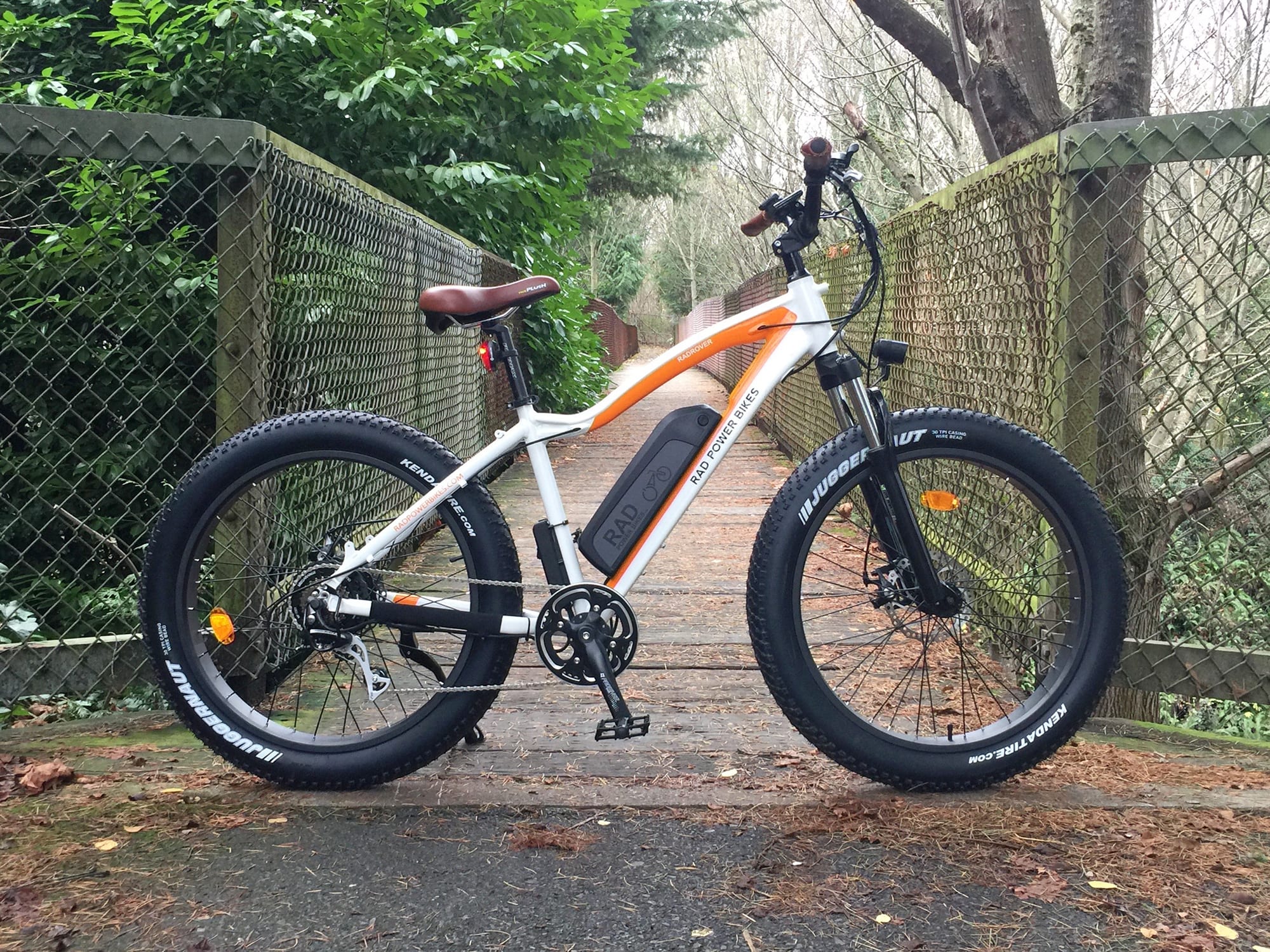
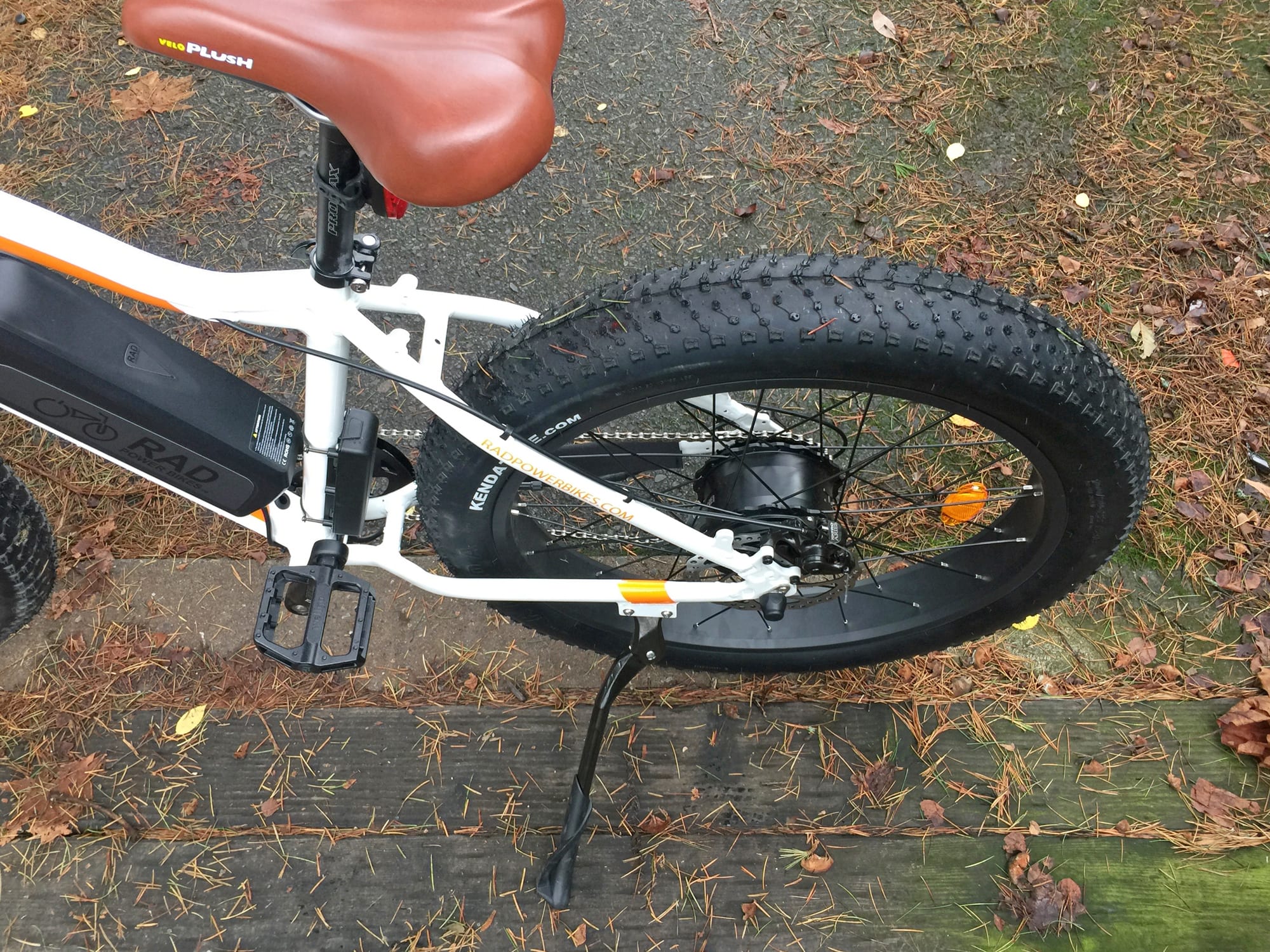
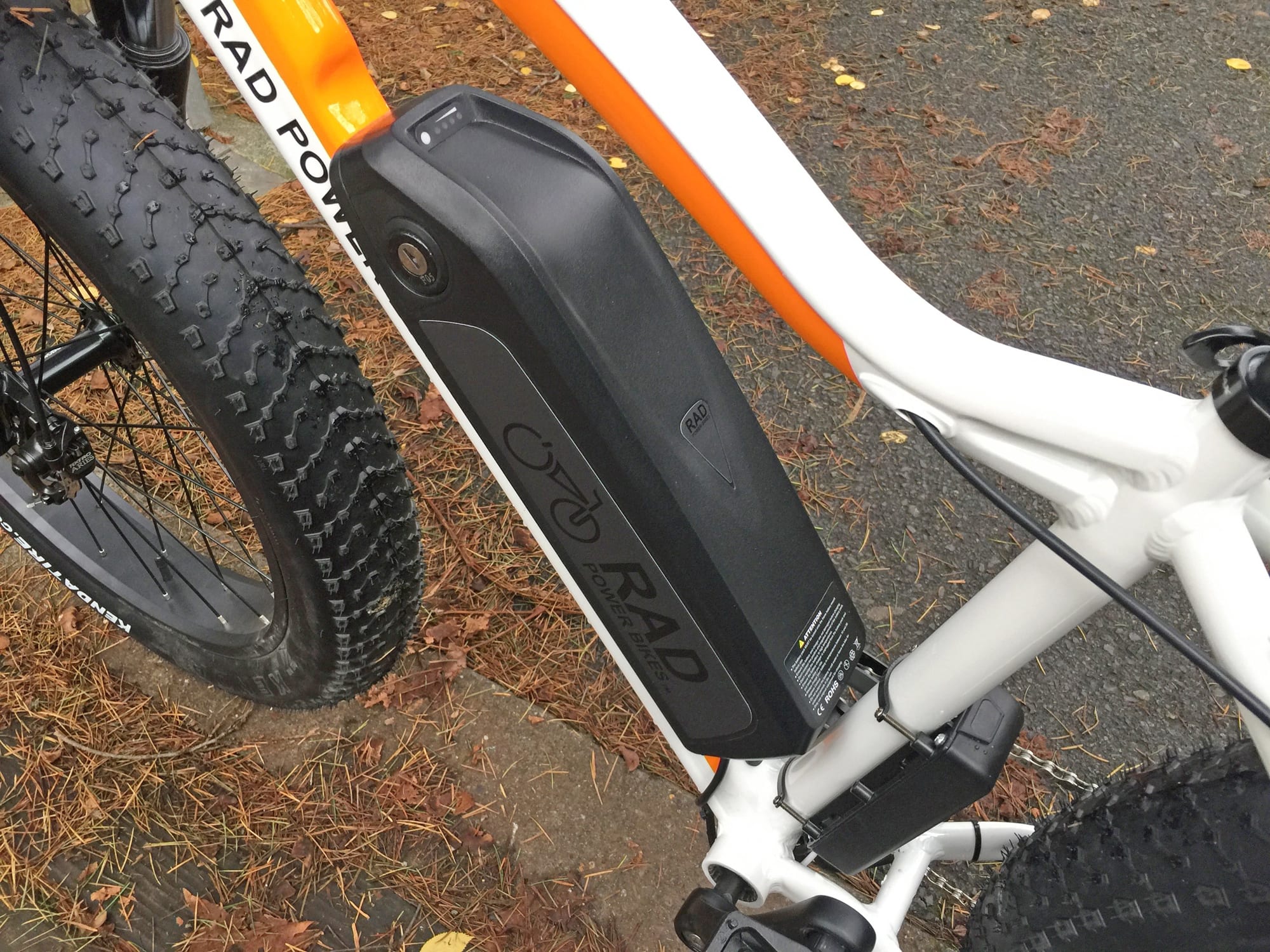
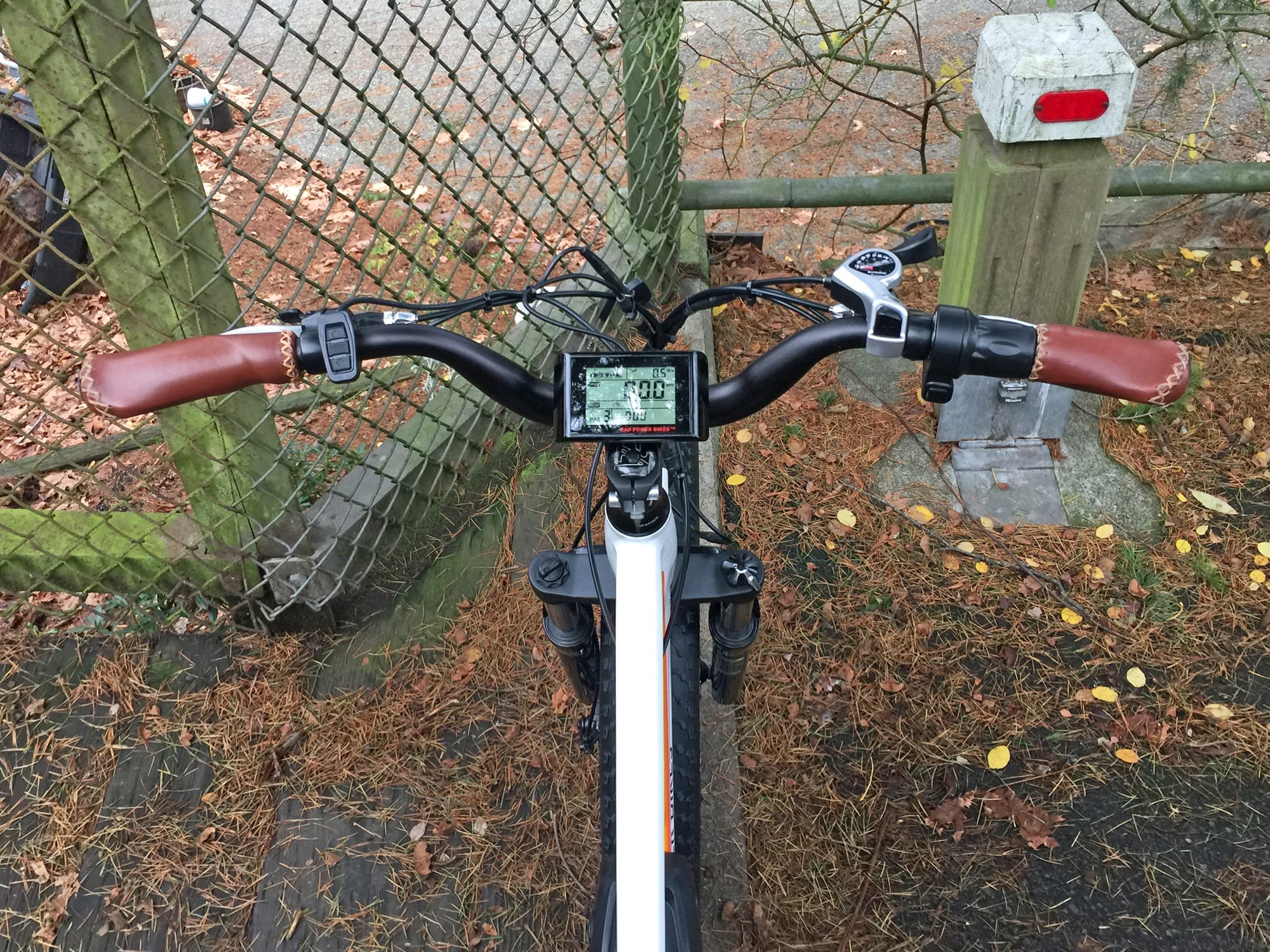

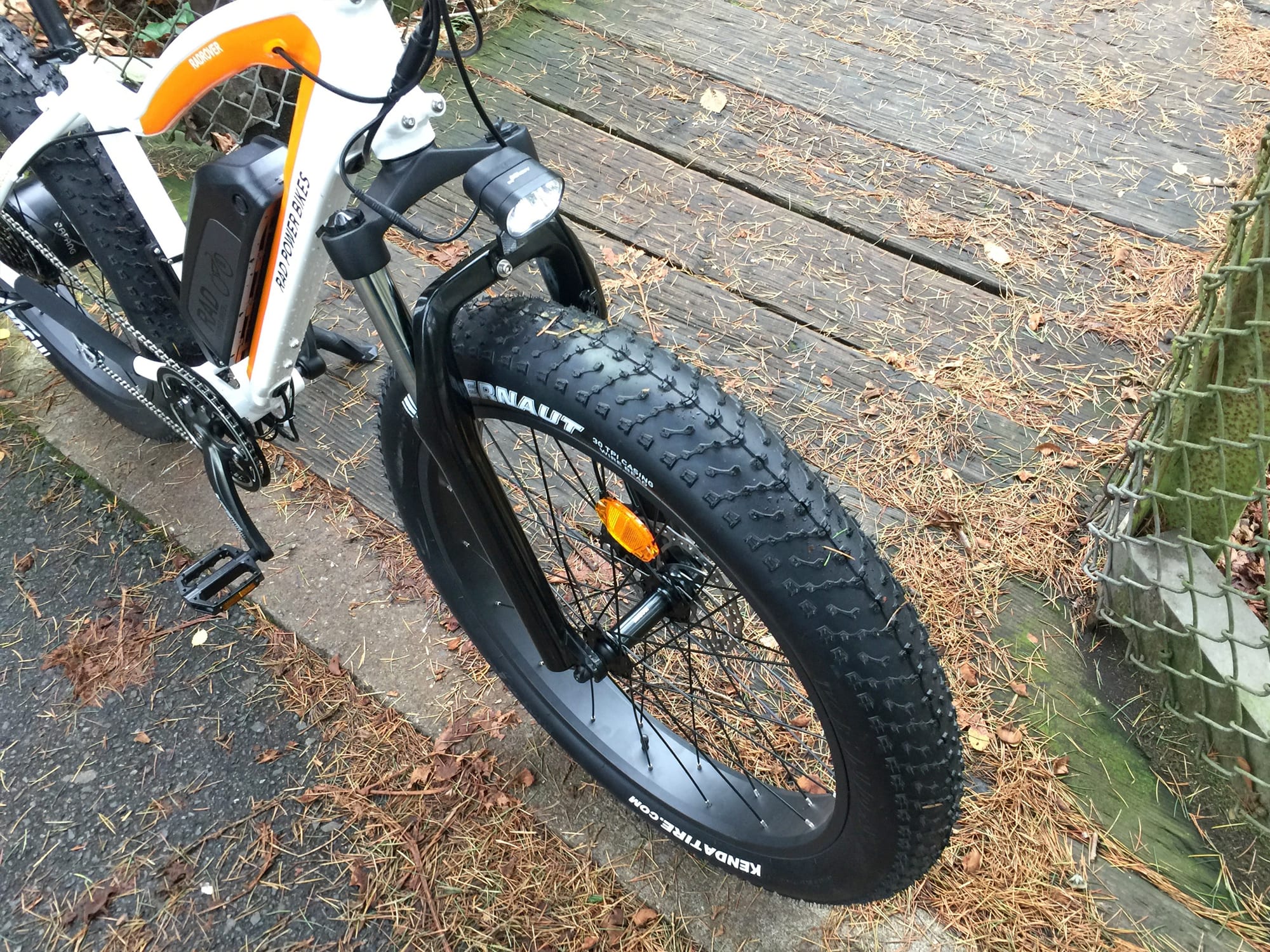
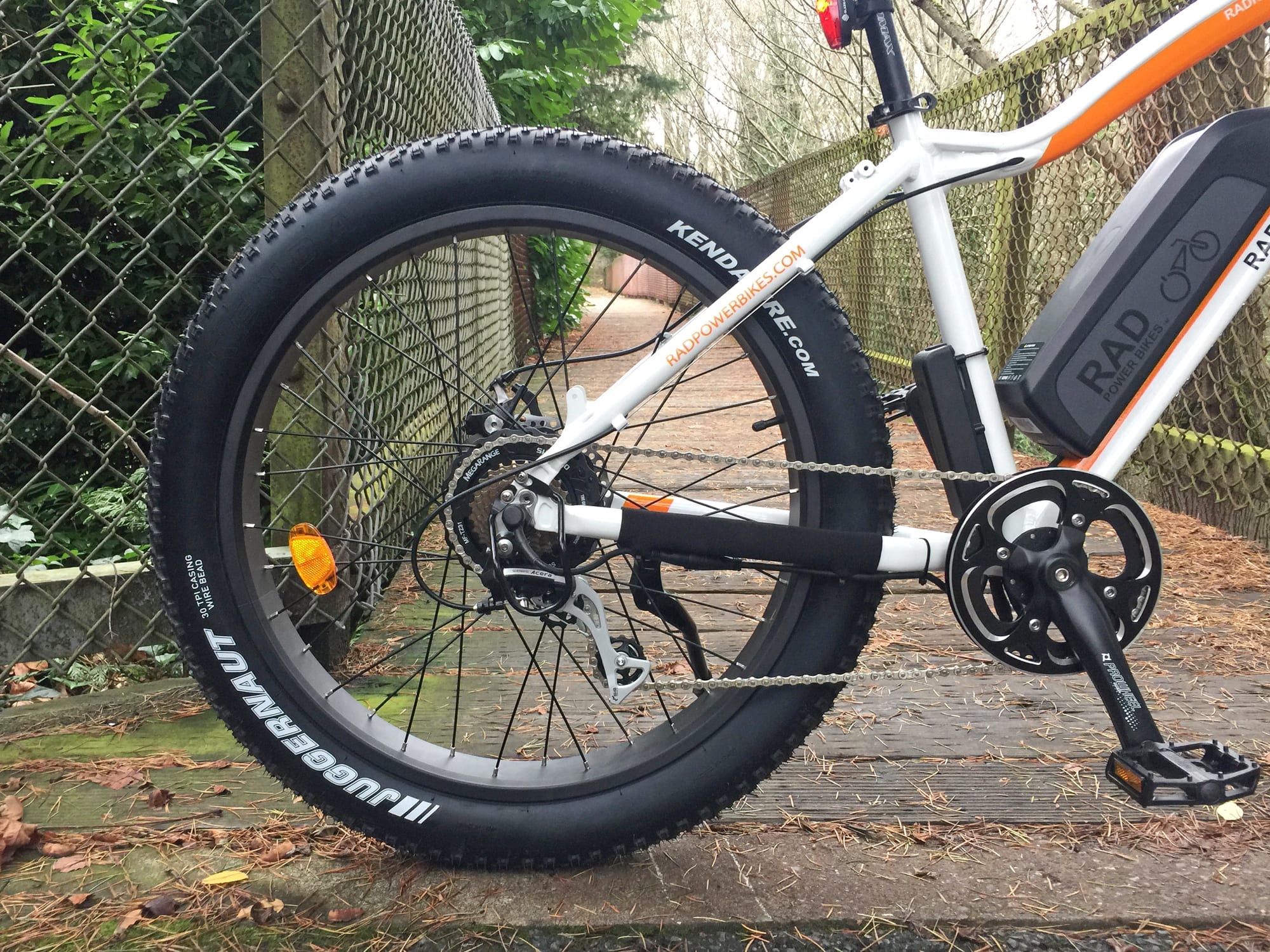


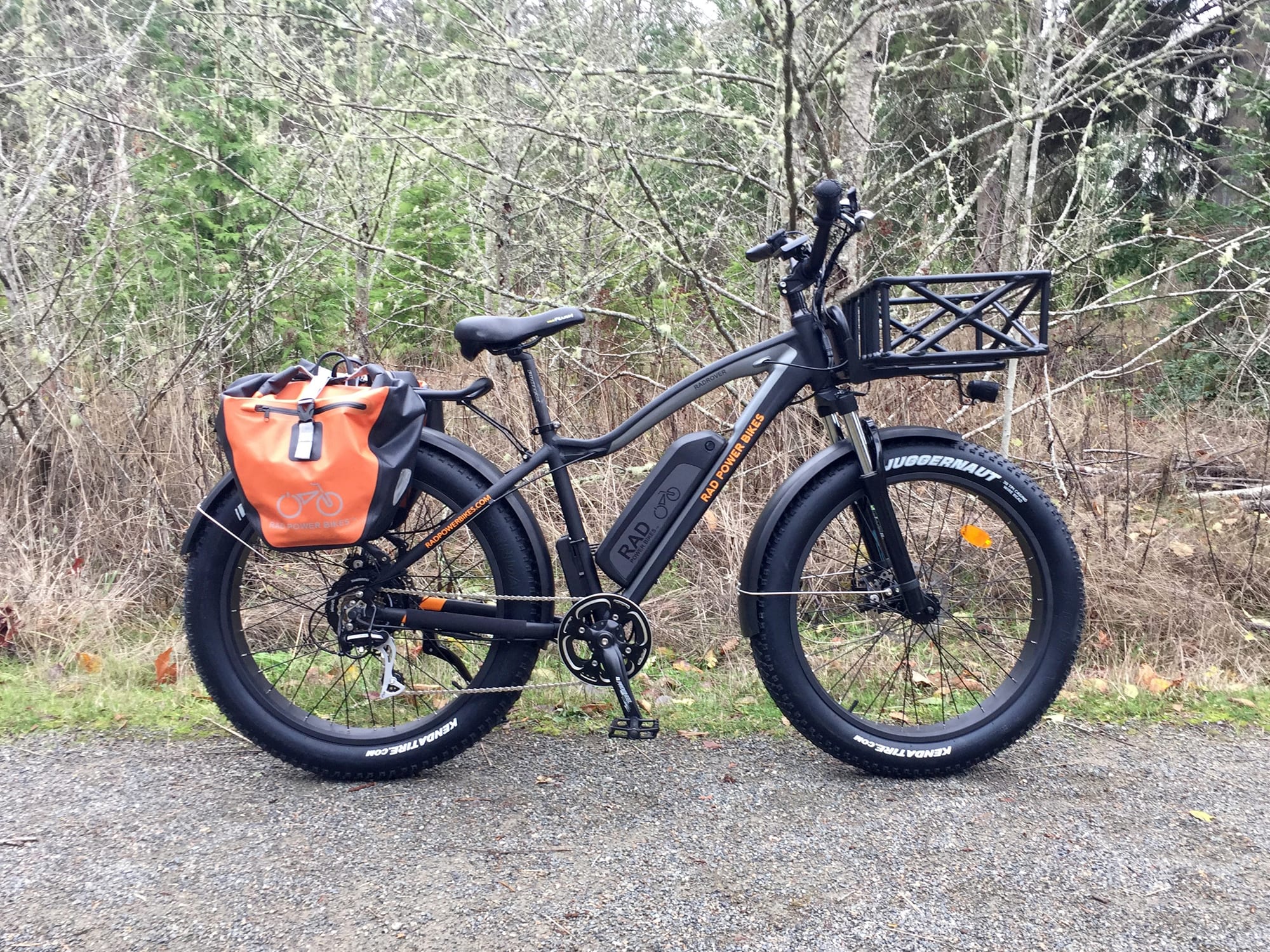
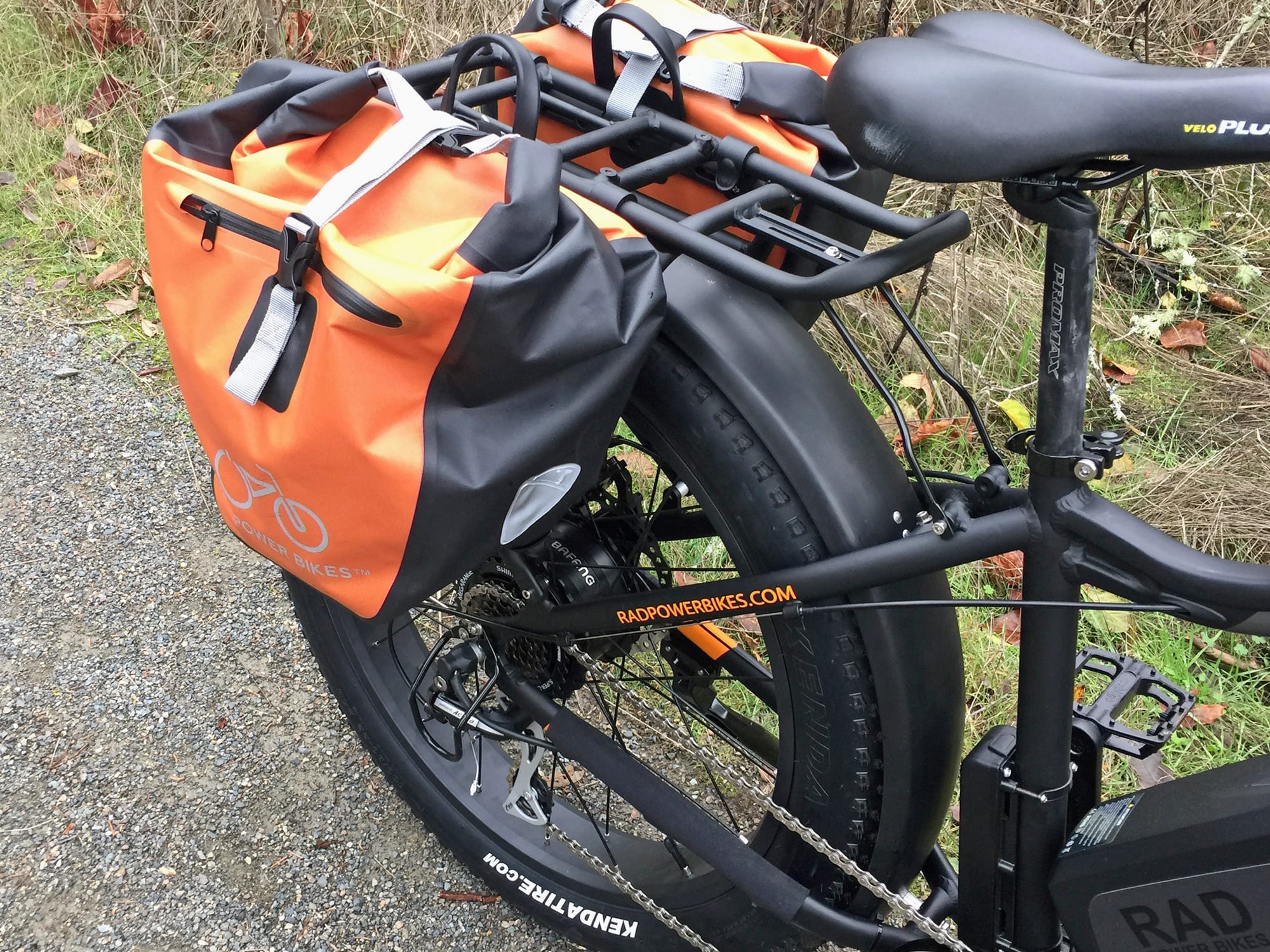
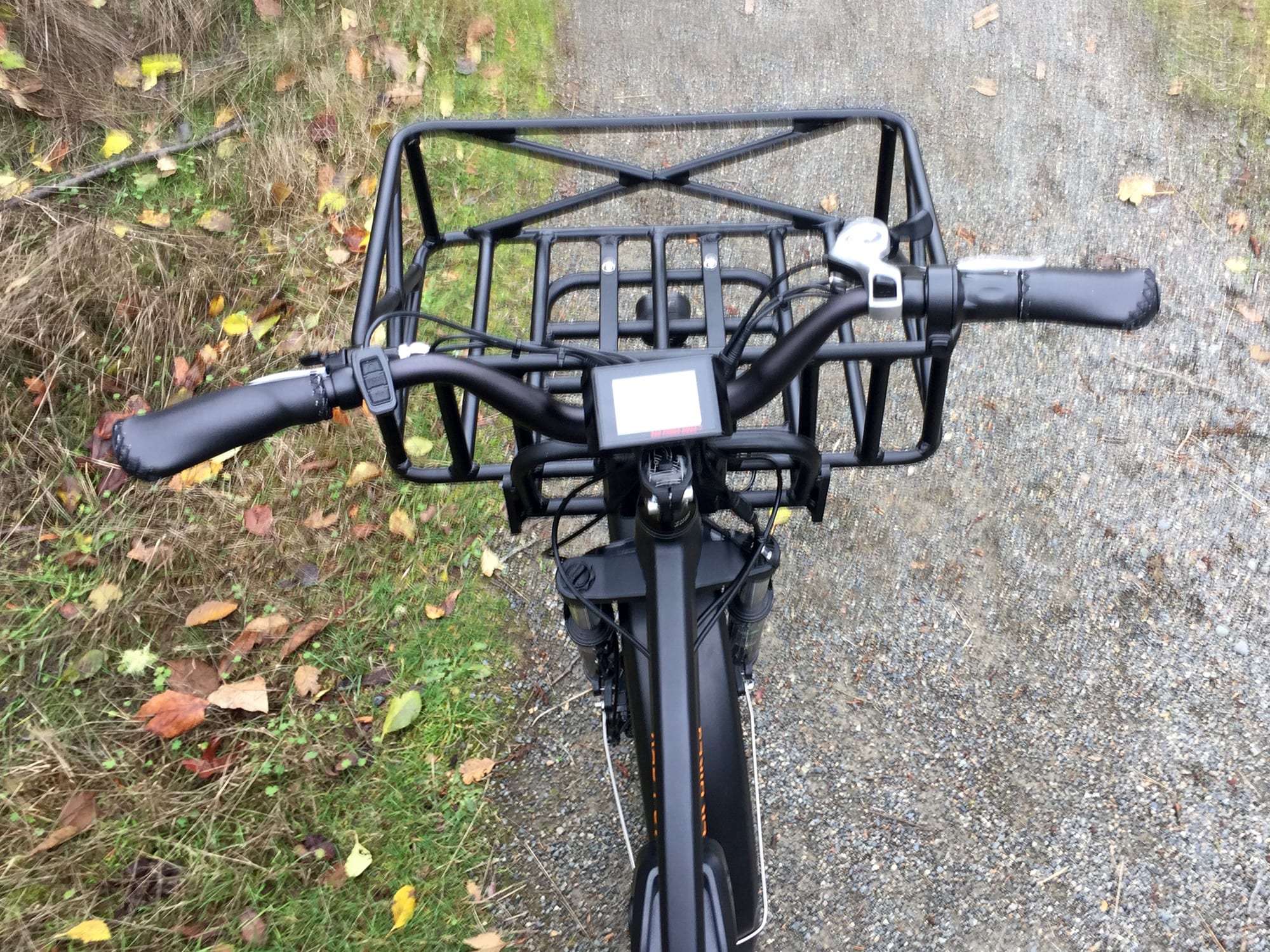
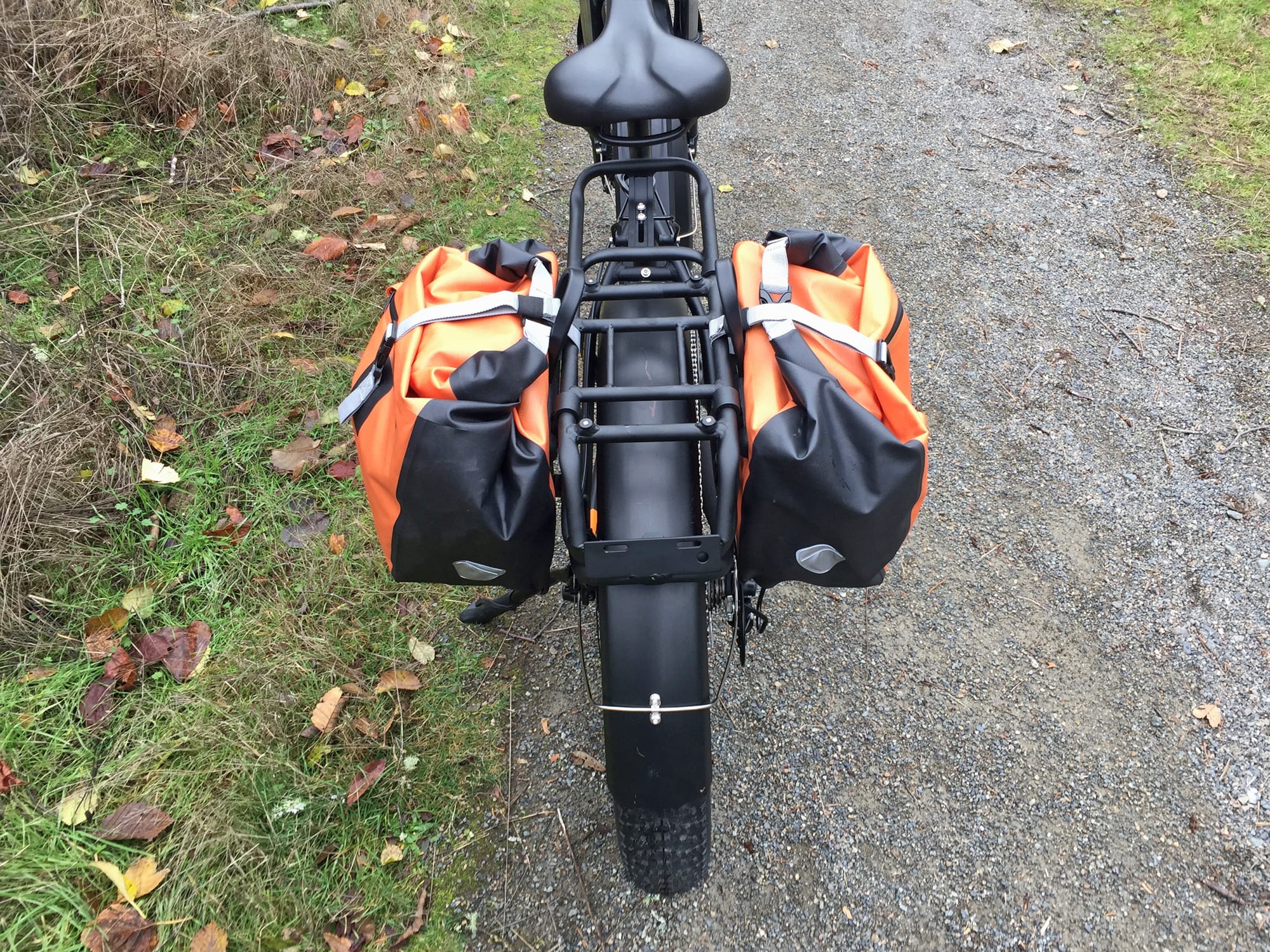
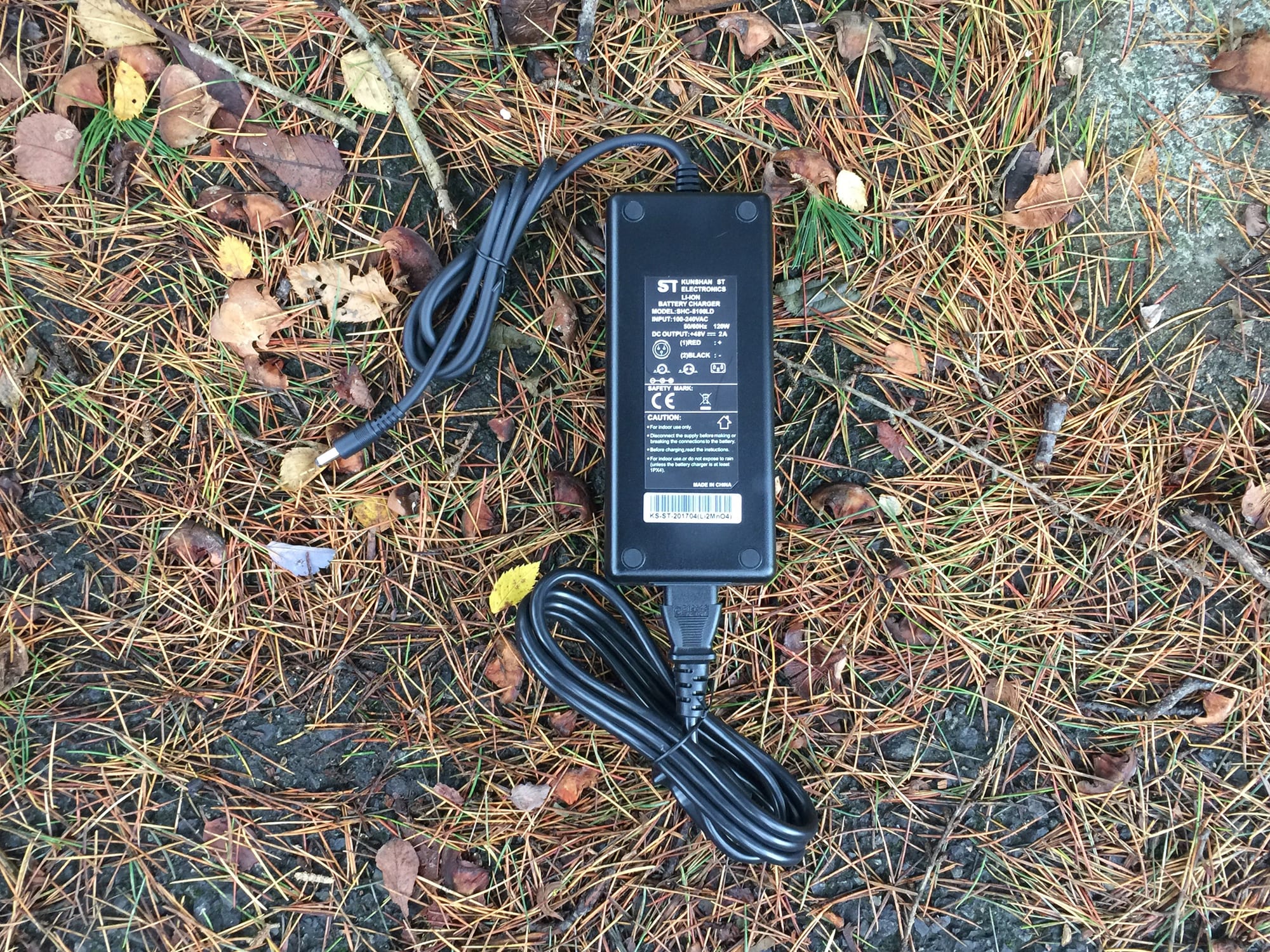

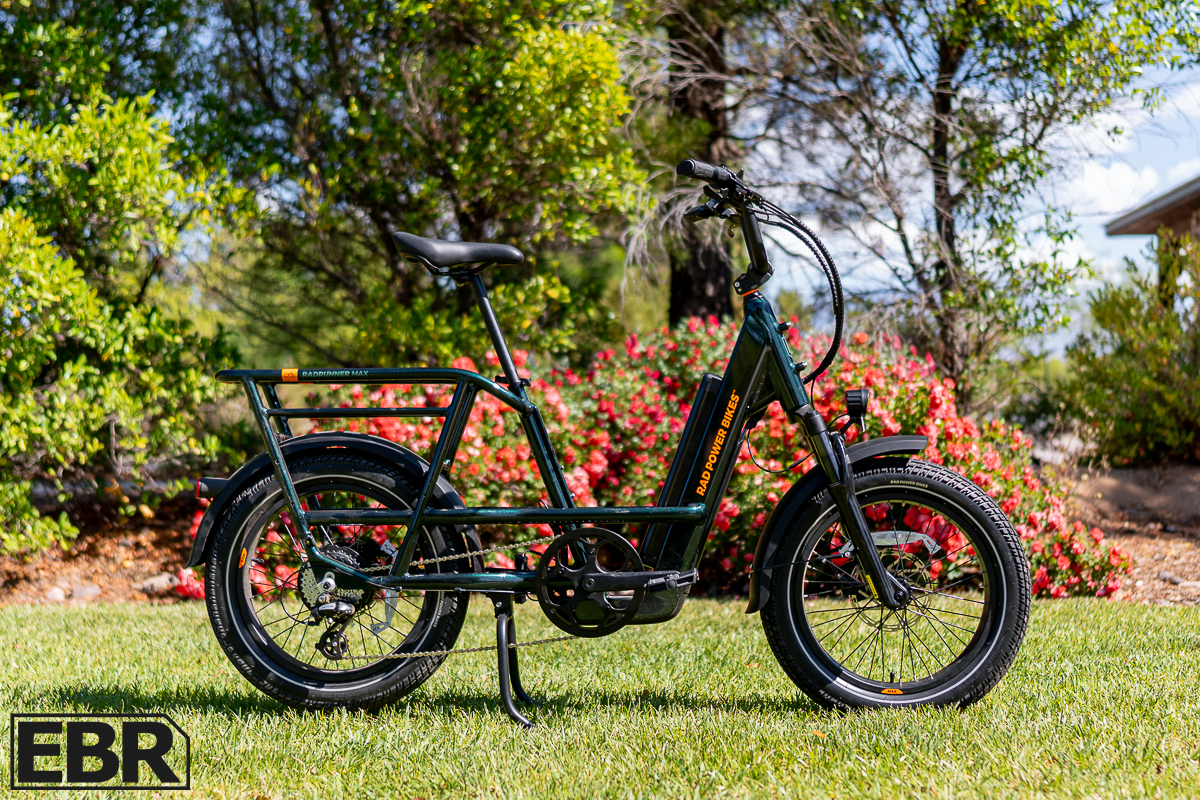
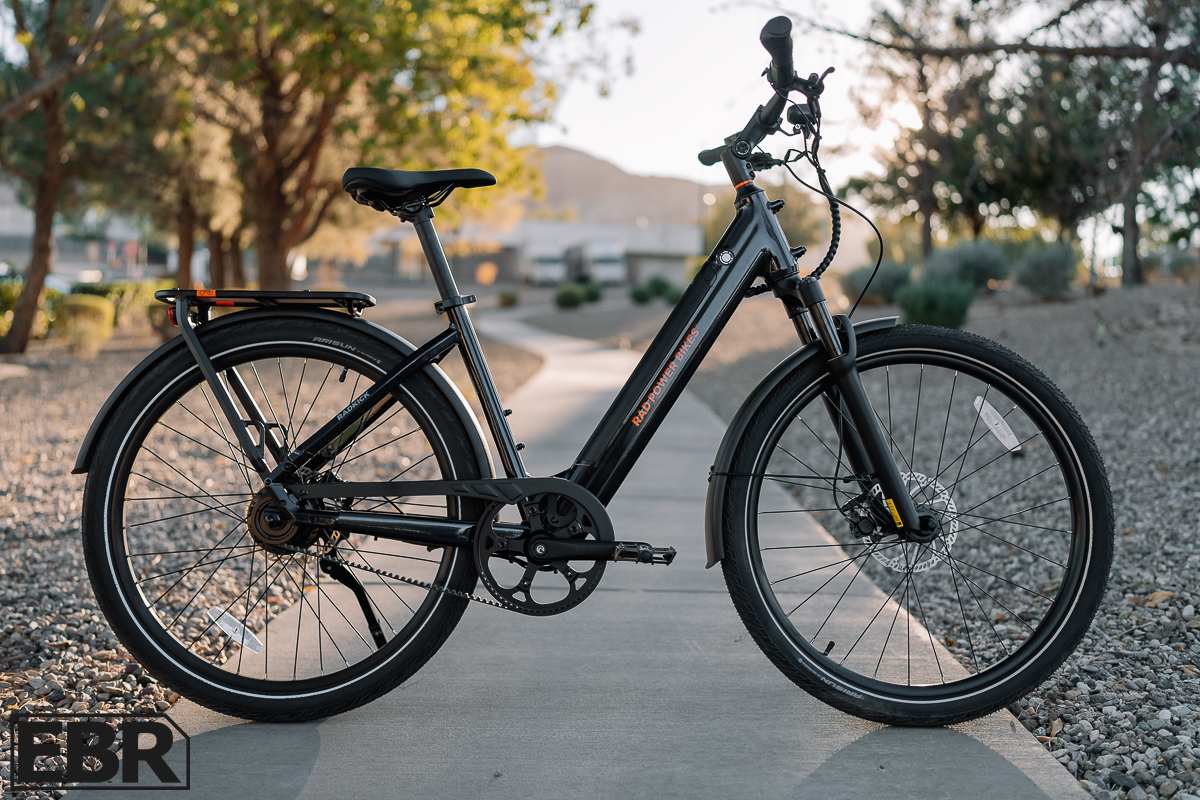
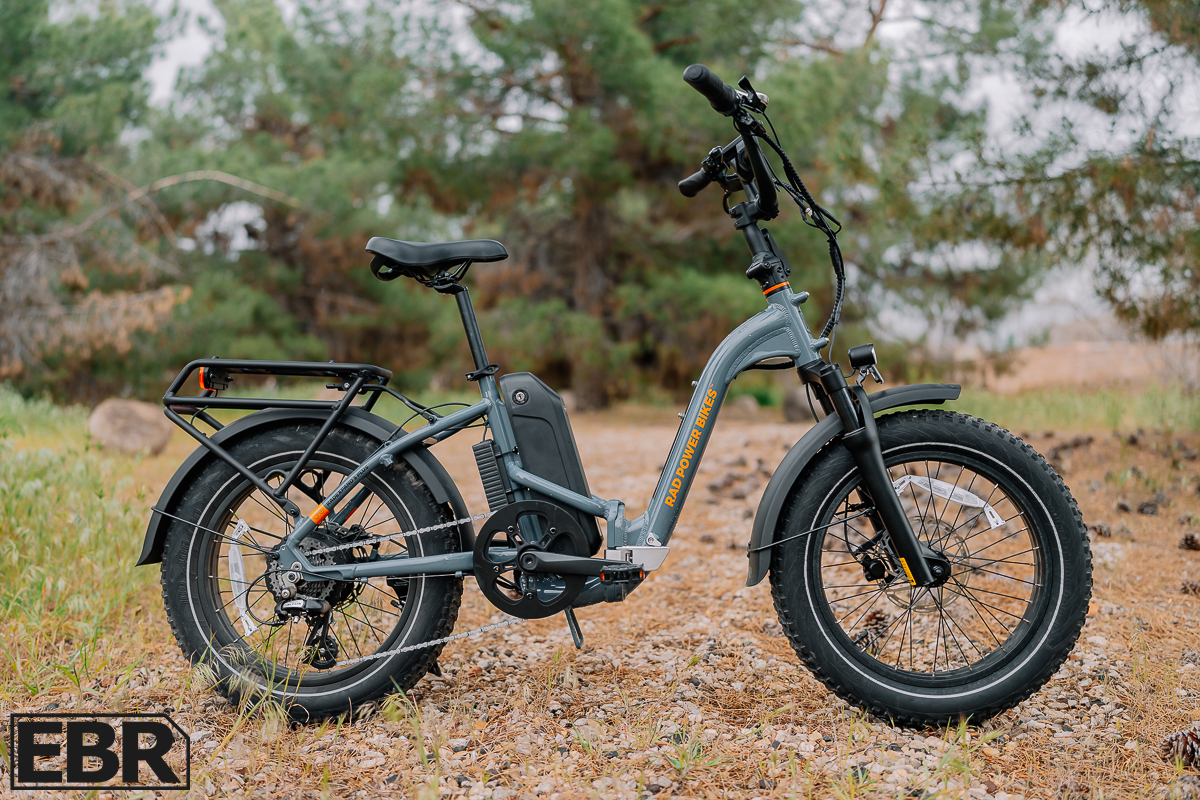
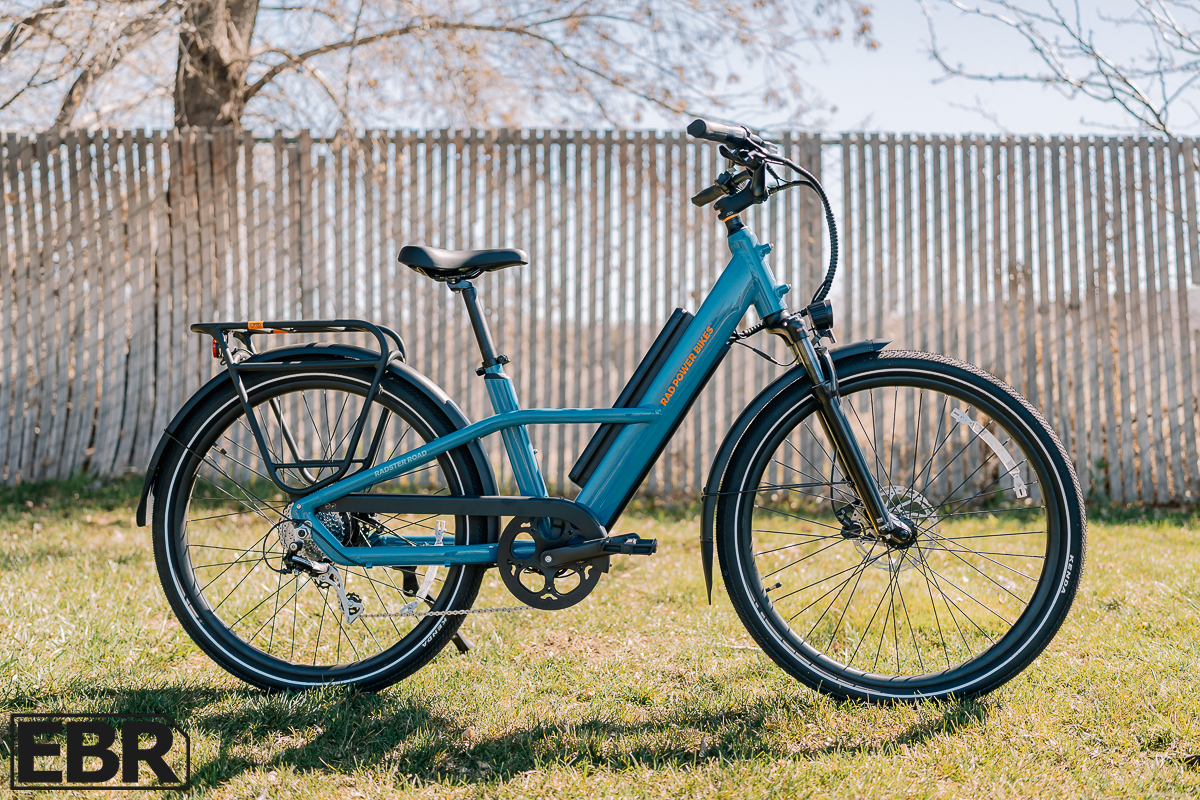
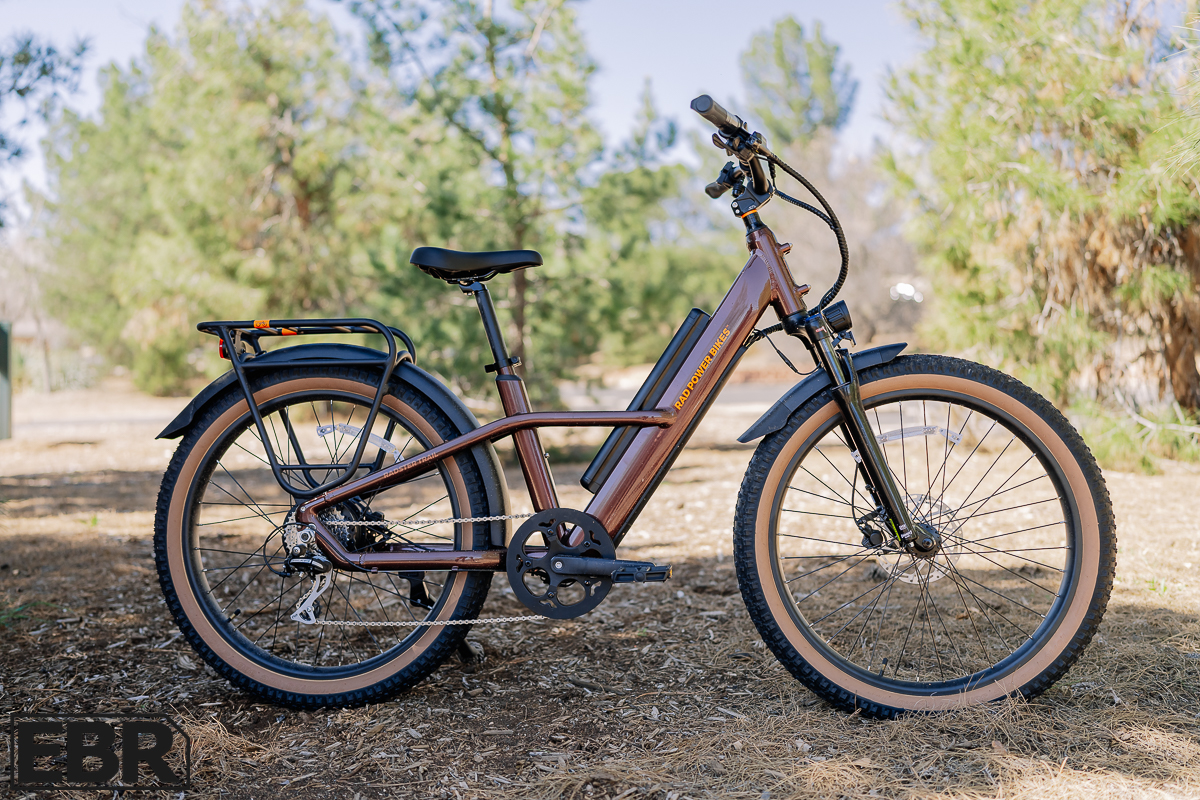
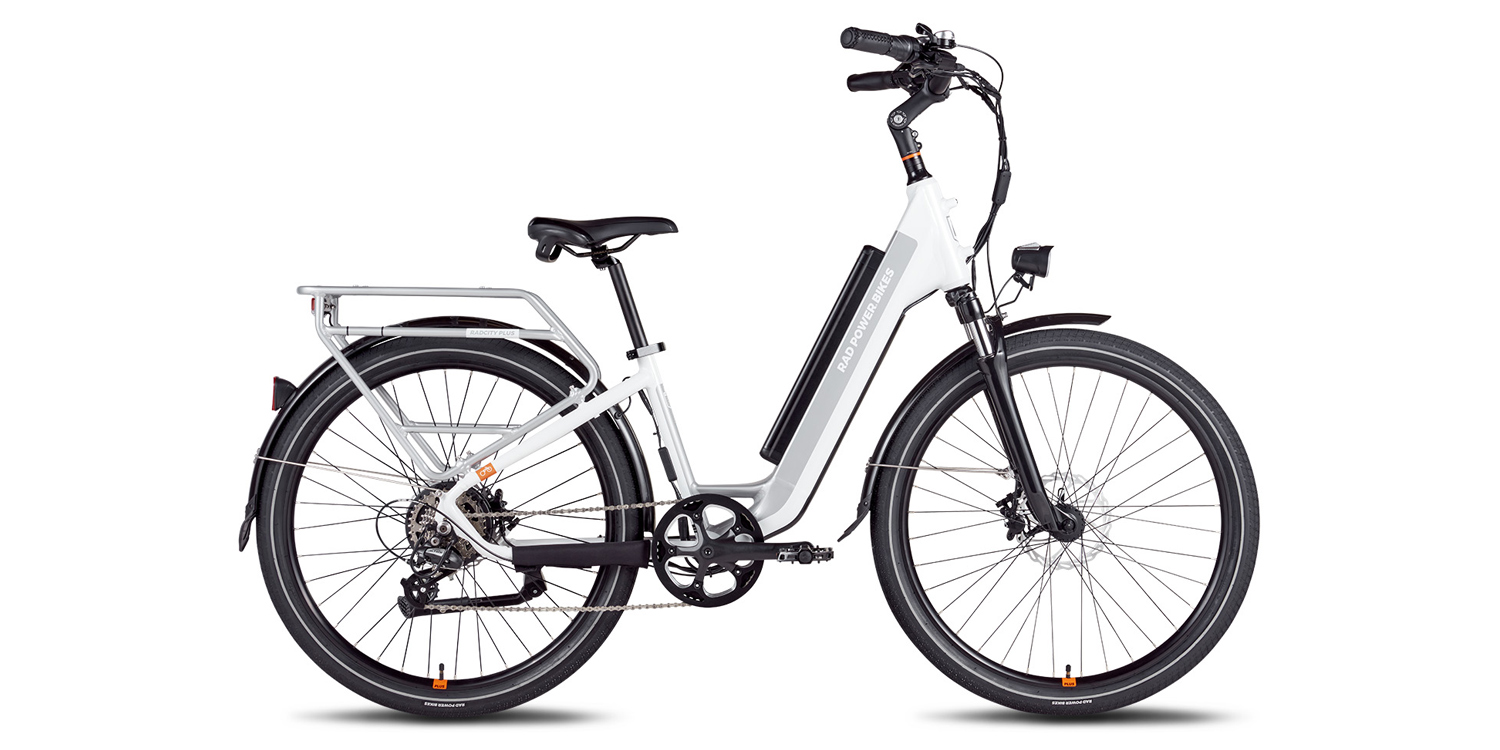
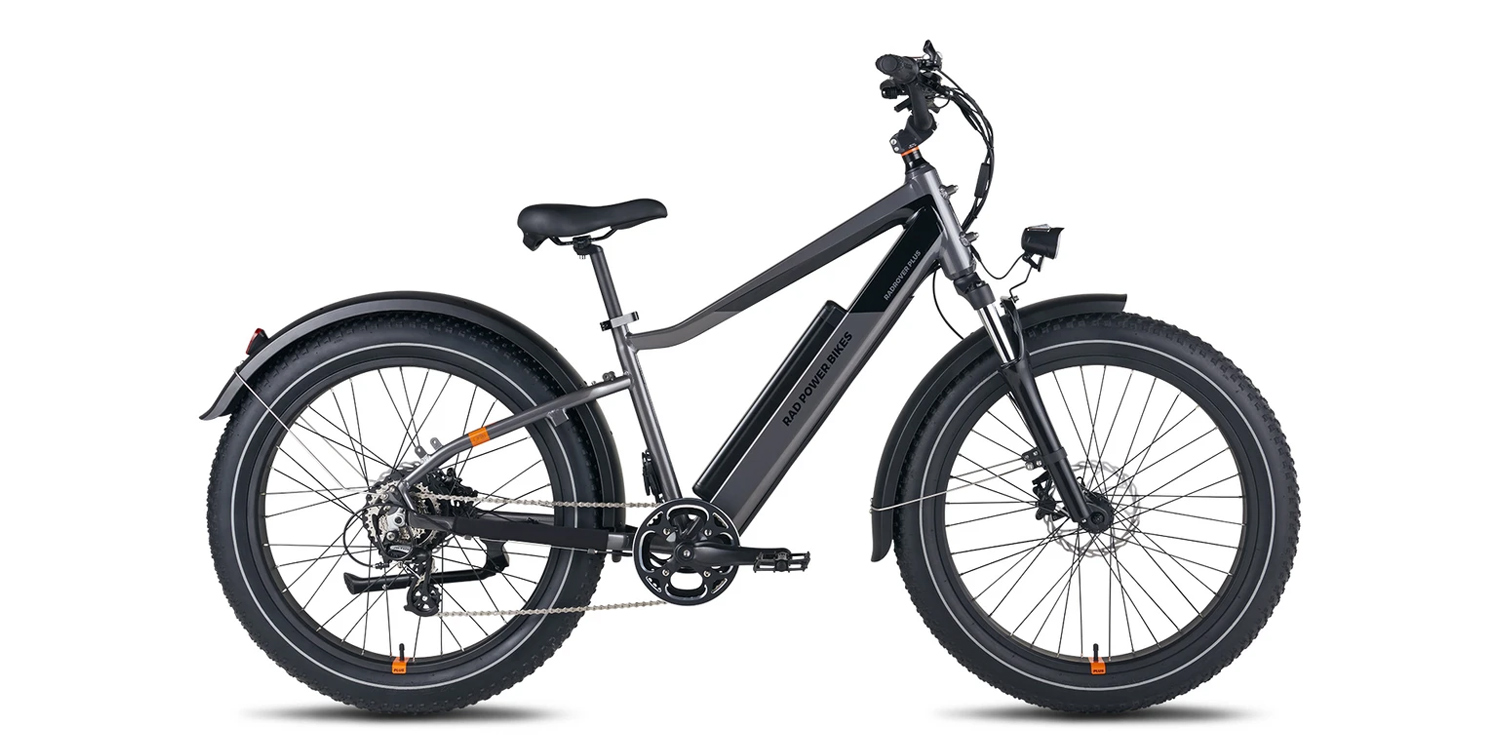
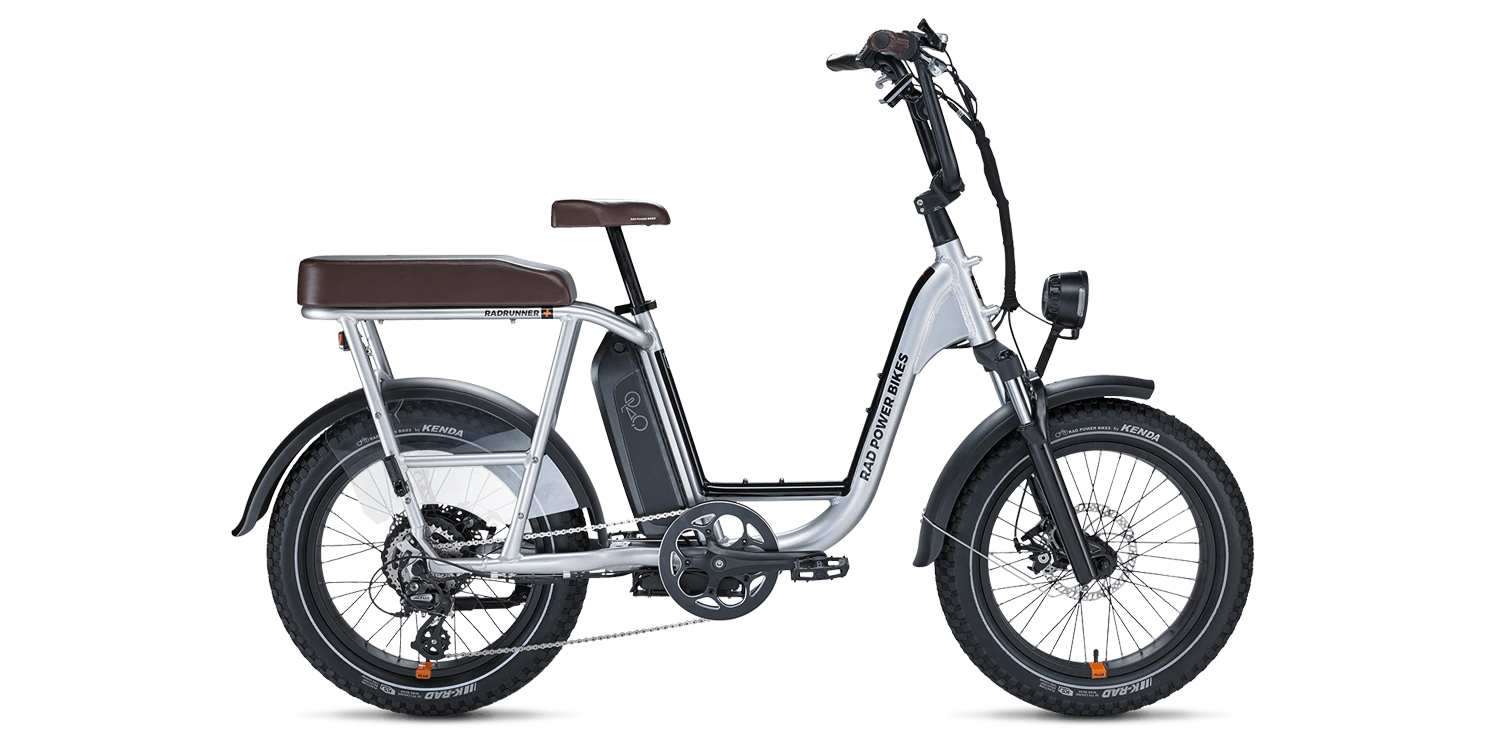
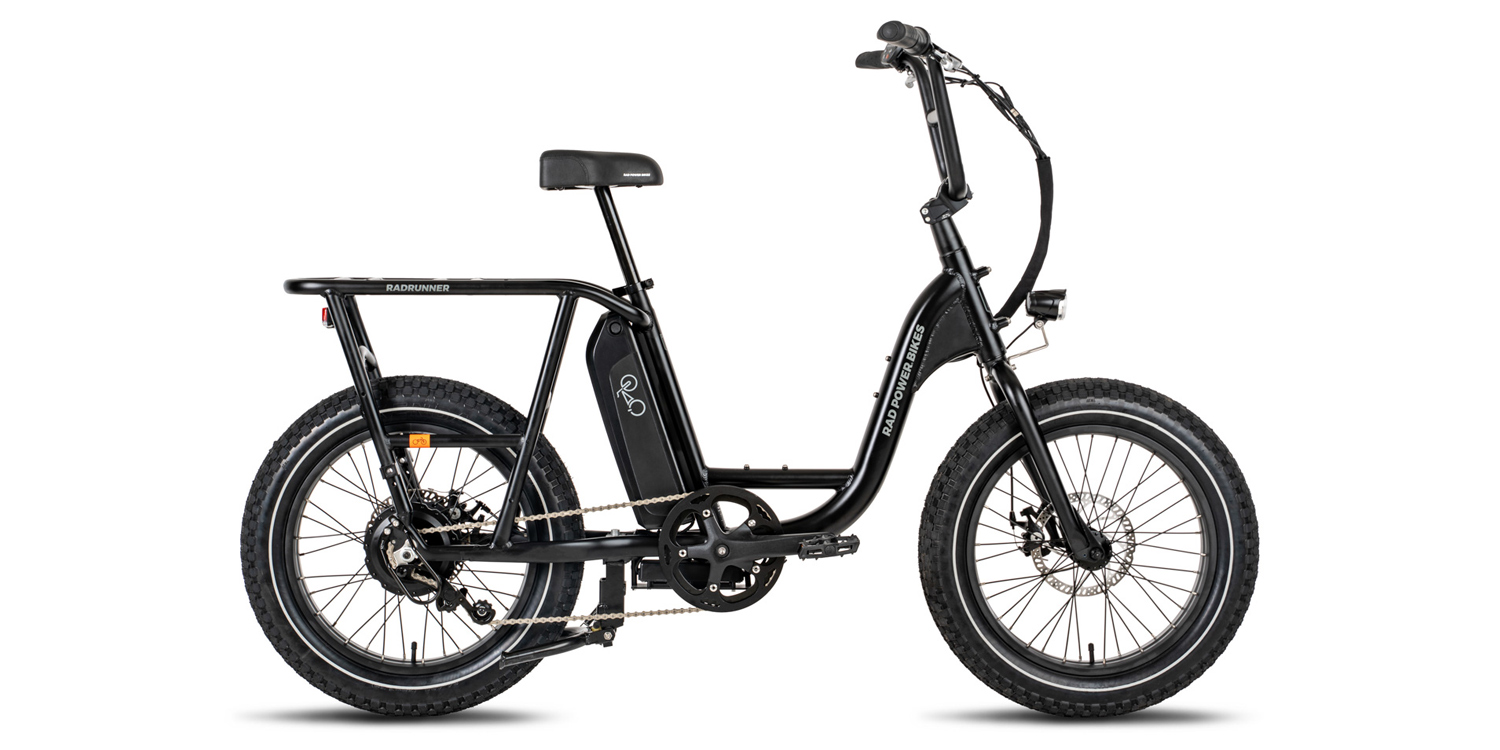
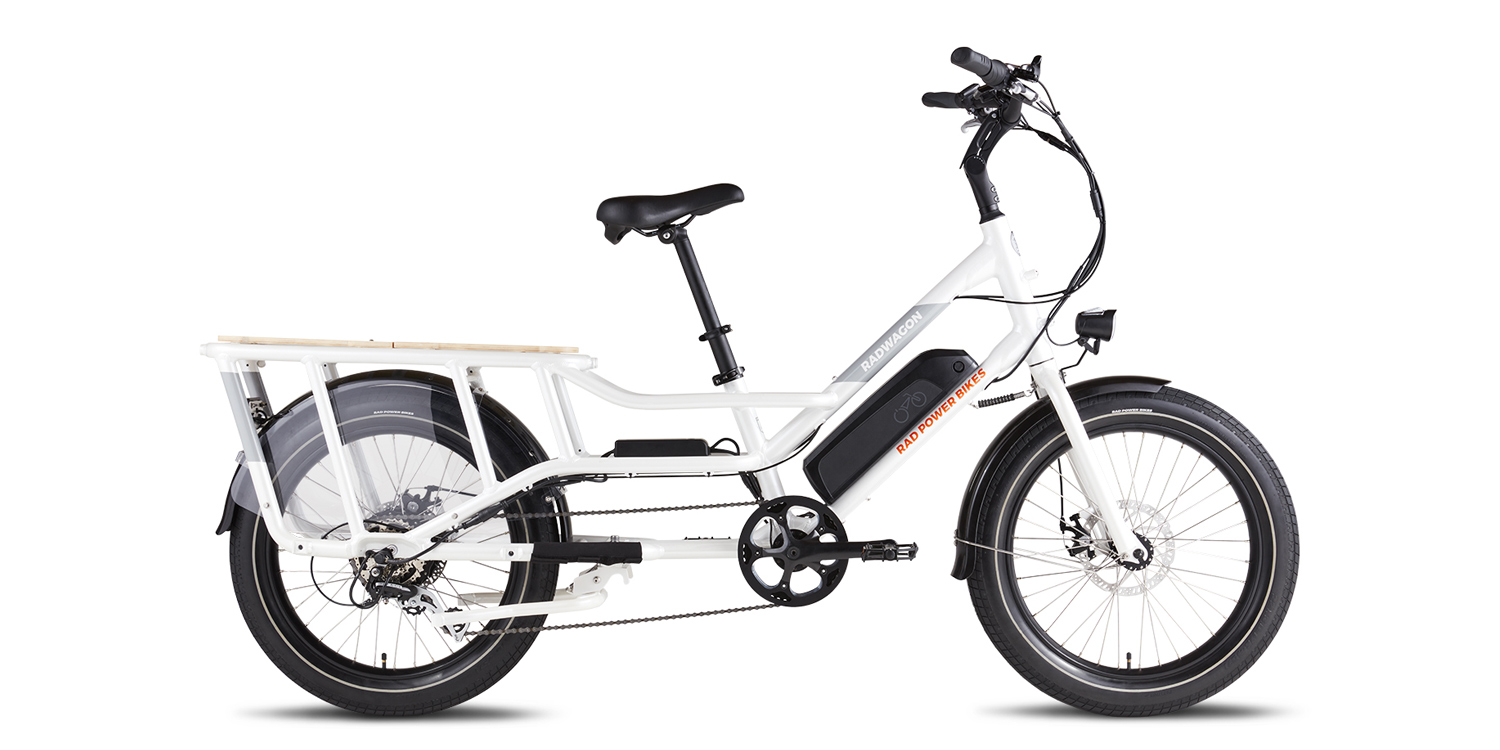
Marty says
On the previous Radrover, you could set the display so as to reach 25mph. Do you know if this option is still possible on the 2018 bike?
Court Rye says
Hi Marty, I think the display menus and settings are the same as before. I heard something about raising the speed to ~23 mph when we were talking about the 2018 models so I would guess that yes, you probably can raise the speed a bit through the menu system. I did not test this and cannot say for sure but perhaps someone else will chime in or you could ask in the EBR Rad Forums here.
Marty says
Thank you! Happy holidays!
Vin R says
I just received my 2018 Rover and I can confirm that it’ll let you max it out at 25 mph for pedal assist and throttle. You probably wont want to go much faster than that though as the gearing has you peddling pretty fast at that point.
Court Rye says
Thanks for the feedback Vin! I appreciate your perspective and agree that it can be difficult to go faster than 25 mph based on the gearing (and weight/friction) of this model. Hope you’re enjoying it :)
Dennis Stetter says
You mention 275Lbs total weight, so since the bike is 65lbs, is it 210 lbs recommended max rider/cargo weight for the bike? Is that the same for the 2017 models?
I assume the bike can support more, but I would think range is impacted as weight goes up.
Great review,
Dennis
Court Rye says
Hi Dennis! That’s a great question… I’ll ask Rad Power Bikes and get back to you but my impression is that the bike can support up to 275 lbs including the rider and cargo but not including the weight of the bike itself. So basically, if you weigh 265 lbs and put 10 lbs on the rear rack… you should be good! And yeah, thanks! I did my best to present the bikes thoroughly and fairly, with a bit of fun, and I suppose that climbing ability and range would be impacted by increased weight ;)
Paul Allison says
How many miles can you go before you have to charge it? Also, if you pedal the bike, does it recharge the battery?
Court Rye says
Hi Paul! The range depends on many factors such as rider weight + gear, tire pressure, inclines, and weather (wind and rain in particular). If it’s very cold out, the battery won’t go as far. A complete refill will probably take about six hours on this ebike because of the higher capacity and average two-Amp charger. This particular Rad Power Bike does not offer regenerative braking but the RadCity and RadWagon models do. You can learn more about pedaling to generate energy from this video. I hope this helps!
Marty says
Hey Court, one more question. I noticed they make a European model that features a built in tail/break light. Any idea why they wouldn’t offer this to us? I mean it’s an American company, why wouldn’t we be afforded the same features? I see this as a very important and safe option.
Court Rye says
I like those options too… I think Rad Power Bikes included them in Europe because of legal requirements. Maybe they could start offering this stuff as a stock option for the RadRover in the future? It’s cool that they at least have the rear rack, maybe you could ask about a rear light or other upgrades if you contact them. I hope this helps :)
Marty says
Thank Court! I actually ask them if it was possible to have the 2017 handle bars on the 2018 model, and they said no. So I can’t see that happening. I’m assuming they are shipped from overseas and built one way, and that’s what you get. Which is okay too. I’ve followed their company from the beginning and can’t wait to finally own their bike! They seem like great people!
Court Rye says
Hmm, thanks for the update Marty! I enjoyed digging into this a bit with you and appreciate the follow-up :)
Luke says
Hello!
Thanks for all of the great reviews. I’m looking to get my first electric bike and I’m torn between the RadRover Electric Fat Bike and the Juiced CrossCurrent S.
I live in Austin, TX, so it will be a lot of city biking, but I will be riding on bike trails, paved and not paved. Most I would do in a day would be about 20 miles round trip, so range shouldn’t be a huge issue for me. I like the Juiced Bike because it seems like you get a lot of bang for your buck. The RadRover is intriguing because of the fat tires and overall build.
Do you all have any thoughts on what might be best for my situation?
Thanks in advance!
Court Rye says
Hi Luke! I used to live in Austin, that’s where Electric Bike Review started :D
Anyway, those are two very different ebikes, but both offer great value. If you are okay with the extra weight, the RadRover will probably be more comfortable and fun to play with… but if you live up stairs, expect to have to fix flat tires, are wanting to ride faster on the streets etc. then the Juiced Bikes CrossCurrent S is going to take the lead. My ride style is more sporty and fast on road, so I’d tend to lean that direction… also for convenience at the bike rack etc. but I also love mountain biking and there are some fun spots near Zilker Park, like back behind Zilker Springs etc. that would be great to explore. I think you’ll be happy with either product to be honest. Perhaps there’s someone selling a used RadRover on Craigslist that you can test ride before you make a final decision. Also, check out Rocket Electrics as they have bikes you can test ride to see what the CrossCurrent S might feel like (or if you like one of their bikes even better). Good luck!
patrick obrien says
I love your reviews have not got a ebike yet but you are making it easy with your awesome reviews!
Court Rye says
Awesome! Thanks for the positive feedback Patrick, we’re doing our best to help you out. I’m glad you’ve enjoyed the space ;)
Jeff w says
Hi Court. I enjoy your thorough reviews. you have so many bikes to choose from, I suspect that it gets harder to decide what is best for when. I have that issue with just two. This one and the VoltBike Yukon. With Rad Power in Canada now, what was a clear choice is not so clear. The Yukon with fenders rack and shipping runs $1959C while the rad runs $2000 but without rear rack and fenders which adds about $250. The Rad has a higher-end derailleur and better chain control but… how about the bigger things like is the front shock better, does the bike accelerate smoother under power, is the ride smoother and have more comfortable ergonomics? in your view, what do you think is better or are they so close price should be the deciding factor? Your opinion would be appreciated. Jeff
Court Rye says
Hi Jeff! I heard that VoltBike may have updated a few features recently on one of their other bikes, so I think the RadRover and Yukon may be very close spec-wise. Perhaps the choice should be made based on how the bikes look and the battery style, because I think the performance is going to be similar. Rad Power Bikes seems to be a bigger operation that VoltBike, but both are offering excellent customer service. It is neat to see RPB expanding into Canada, I really like their stuff, but I also appreciate VoltBike. Shock performance may be the same (especially if they upgraded recently on the VoltBike). I cannot say for sure if they are using a trigger throttle vs. twist, but that may be a consideration too, especially if you have a preference or have a wrist sensitivity. I wish I could be more help, maybe someone else will chime in with feedback or you could post in the help choosing section of the forums.
Adrian Johnson says
I was wondering If I could inquire some assistance, I noticed the weight limit you recommended on the bike. I’m in a desperate search for an electric Fat tire Mountain bike that can handle well me. I’m 6’2” (187cm) and 320 lbs (145.15 kg). I live in a mountainous area with lots of hills. I’m an entry level bike rider and would be using my bike for mostly daily commute. I’m looking to start my bike search with the price tag under $2,000 USD
Court Rye says
Hi Adrian! this is a tough one… I know people who exceed the maximum weight limit of all sorts of electric bikes and have done just fine. I think the companies set it lower because they anticipate different sorts of riding and know that the service interval and warranty would change with heavier use. The RadRover seems well built and could probably handle your weight just fine on smooth streets and light off-road. The issues I hear about from heavier riders include loosening or broken spokes and flat tires. If you keep your tire pressure at what is recommended (the higher end of the range) and take bumps and rough terrain a bit slower, I bet the bike would do fine for you, especially with the fat tires. I hope this helps and I feel that the RadRover is one of your best bets for the $2k price range. They have excellent support and have custom designed the frame with that nice suspension, which will also help you out. Feel free to ask around more in the Rad Power Forums but if I was in your position, I’d probably just go for it and be careful. I’m highly doubtful that easy riding would break the frame or anything, just wear through some of the wheel and tire parts more quickly.
Mark Wheatley says
My wife has waist and finger sensitivity. Would you recommend the Rad or Volt? We want the fat tire model. Thanks for you help.
court says
Hi Mark, they are both pretty similar. Maybe it comes down to her preference for a twist throttle (Rad) or the trigger throttle (VoltBike). You might also want to check that those types of throttles are still being used since this review is newer than the VoltBike and both brands are constantly making little adjustments and improvements :)
Yacov says
By pressing the down arrow for 2-3 seconds you initiate walk mode. How you stop it?
court says
Hi Yacov, I think you simply let go of the down arrow and the motor will stop (or you could pull either brake lever because they have motor inhibitors built in). I hope this helps :D
Jason Randolph says
Thank you for your very thorough reviews. I knew nothing about e bikes and the associated companies but your site fixed me up. It’s by far the best resource on the internet.
I went with the Rad Rover based on your review and after looking at many other options. When the bike arrived damaged due to poor UPS handling, I called Rad Power and they were exceptionally helpful. They processed an order to send me replacement parts within 15 minutes, free of charge. OUTSTANDING customer service.
Huge shout out to Rad Power for being an awesome company, and to you for your review and recommendations.
-Jason
court says
That’s awesome, thanks for sharing your experience with Rad Power Bikes. It’s really helpful for the company to be recognized for their good support and probably reassuring to other potential customers. I hope you enjoy it this summer and for many years to come :D
Gary says
Hi, can you please explain what you meant by Canadian bikes may have a 500 watt motor?
court says
Hi Gary, I think the legal limit for electric bicycle motors in Canada is 500 watts vs. 750 watts in most of the USA. The motor hardware may be similar but the software or firmware may limit the motor performance just a bit in order to be in compliance. Perhaps Rad Power Bikes could elaborate more on this if you post in the forums here. I basically just shared what was explained to me, but I have not tested this and I do not know as much about the different regulations as I could.
kim says
which is the best to do? let the battery run down, then charge it or charge it often and don’t let the battery die.
court says
Hi Kim, I’ve been told that Lithium-ion batteries are “happiest” when maintained between 20% and 80% but are better off being 100% than running low because that can change the chemistry inside and stress them. Avoid dropping and other hard impacts, avoid extreme heat and cold :)
Robbie J says
Great review and thank you for helping me choose my first e-bike (ordered my RadRover the second it came into stock today). Keep up the great work!
court says
Fantastic! So glad the site has been a useful resource for you in choosing an electric bicycle. I welcome your thoughts on the product once it arrives and is ridden a bit. Rad does a great job and I suspect that you’ll enjoy it a lot :)
Jong Lee says
After my maiden voyage of 23 miles round trip commuting on a hilly road/bridge, I’m impressed with the battery life. It took me 40 minutes one way. Do wish it had more power with more top speed, as when I bike in the morning I don’t want to break into a sweat. But on the ride home, I got some good exercise, even with PAS level of 4. I do like the bell and found the seating position fairly upright (as assembled by Rad). They put the tire pressure at 20psi, but I pumped it to 30psi as I plan to keep it on roads. The rear light was cheap, so replaced it with a better one I already owned. The padded grips were quite comfy as I’ve never had anything other than a rubber flat tube-shape. I actually thought that the power charger was nice and light and it didn’t feel cheap. Just wish the cable was a bit longer.
The entire ordering process was a bit clunky in hindsight, as I’m waiting for some of the accessories to show up at my house (with shipping charged), then I plan to take it to Rad HQ to get it assembled. Then again, I ordered the bike on a Tuesday in-store and got it 6 days later including assembly, so it was nowhere as long as the 2 to 3 weeks they predicted.
court says
Hey! Thanks for sharing your experience with us, Jong. Sounds like you’re enjoying the bike but it’s nice to hear the little quirks and suggestions for Rad (like the longer power cable idea). I hope your accessories arrive soon and you’re back out riding with an even better experience. Great call on the rear light upgrade ;)
Joe says
50 miles on the bike…
I’m 50 years old, bought the bike to get me outside and a little exercise… The bike essentially is falling apart. Radrover has offered to send replacement parts. Great. The bike is a lemon. Typical of this generation. You get what you pay for. $1,500 down the drain.
Court says
Aww, that’s such a bummer, Joe! It does sound like maybe the bike you got has some big issues… maybe it was dropped during shipping or something. Typically, you do get less service and quality with a low priced product, but my experience (and feedback from other customers) about Rad Power Bikes has been great. It makes me sad to hear all that you’ve gone through with the bike, especially since you’re trying to just get outside for some fun. If you have a Pedego dealer nearby, I’d recommend going in and taking a test ride. All ebikes (and bikes in general) need their tires inflated regularly or they can get a pinch flat, the air just leaks out a but faster than normal because of the pressure and added weight of ebikes. I’ve also had bicycles with broken or misaligned bottom bracket bearings that click, and had others which would pop because the crank arm was bumping the kickstand or frame. The display panel/connectors issue is especially frustrating because the parts can eventually fail and you simply need new ones. Re-routing the cables can be difficult. This is why it costs more for an in-store electric bike like Pedego, but then the dealer makes sure it is setup right and will provide ongoing service for you. It’s still a hassle to get the bikes to them in some cases, due to size and weight. I wish you well and am happy to hear that Rad is responding to your emails and at least trying to help. They are good people in my experience.
Mike says
I noticed that you reviewed both the Rad Rover and the M2S All terrain 750, what bike did you like better? I’m on the fence about getting one of these 2 bikes and would like an opinion from someone who has ridden both. Thanks in advance~
Court says
Hi Mike! I’m sorry to tell that you I (Court) reviewed the Rad models and Brent reviewed the M2S. From what I saw, it looked like a great product… but Rad has been in business longer and provides some of the best customer support and availability in the industry. It’s nice to have choices, I wish I could be more specific here for you… but I just cannot comment on M2S as much because I haven’t ridden their stuff. The founder does seem friendly and responsive, I like how his bikes look and that they offer something cool at a great price point. Maybe you could ask in the “help choosing” section of the forums.
John says
Hi, I am 5 feet 2 inches tall and am considering the RadRover. I am concerned it’s too tall for me. The rad website shows a 5’9″ guy to demonstrate it for short men which doesn’t help me. Can you give some advice on this issue? I wear jeans with 28-inch inseam. can I ride this bike? Thanks.
Court says
Hi John! It sounds like you might be hanging one leg over the downtube of the RadRover vs. having a full standover. This could make it difficult to mount and control when stopping. I’d probably opt for their RadMini, which has a lower standover height… or look at the Pedego 24″ Trail Tracker, which has smaller wheels that make the bike lower. I like that bike because it has a nicely integrated battery and great customer support from Pedego :)
DJ Randolph says
Court,
I really appreciate your site; My Rad Rover came in Monday. Everything was fine with it; very easy to put together. I called Rad as the brakes seemed a little tight and Christian was very professional and easy to talk to. They just need to break in. The front light is brighter than I expected which is good. Going with about 24 PSI as 20 PSI feels a little low on asphalt/concrete. Again, this site has me already thinking about N + 1.
DJ
Court says
Sweet! I’m excited for you, DJ. Sounds like the Rad customer support team has been great… I’m not sure I understand the N + 1 reference, are you thinking about getting an additional bike or something!
pw says
I am maxing out my pedaling with the RadRover at 18mph on flat terrain and would like to know if there is a way I could increase the size of the front chainring to get more speed out of this bike? I have been known to do 40mph on my road bike going downhill. I would like to at least have a bit more work to do at higher top end. Any suggestions?
Court says
Hi pw, yes! I do think that you could upgrade the chainring from 42 tooth to 48t or 52t to achieve a slower, more comfortable and capable high speed cadence. The other approach would be to upgrade your cassette to an 11-36 tooth vs. the current 14-34t. I don’t have a link or specific recommendation, but perhaps a local shop or even Rad Power Bikes customer support reps could help. This might be a great question to post in the Rad Ebike Forums to see if anyone else has done it or recommends parts that will definitely fit. If and when you do this, I’d love your feedback about it!
Anonymous says
Thanks no doubt to the Trump tariff, this bike is now $1699. Bummer.
Court says
Yeah, the price of many electric bikes has risen based on the tariffs that are in place. Thanks for the update!
Paul Hamnett says
The bike itself seems to be excellent. However, the customer service is very poor. I wrote to them asking for assembly help (the photo were clearly wrong) and they basically told me to have it professionally assembled if it was too hard for me. I’m an Engineer – a member of Mensa – and I know my way around a bike. Very disappointing – don’t buy one unless you are an expert – they won’t help you.
Court says
Hi Paul, I’m sorry to hear that assembly and support didn’t go smoothly for you. I’ve heard so much positive feedback around RAD customer support, hopefully this is just a limited experience and I’ll mention it to the company because they have been very easy for me to work with personally. I know that customer support is a big deal when you’re ordering stuff online.